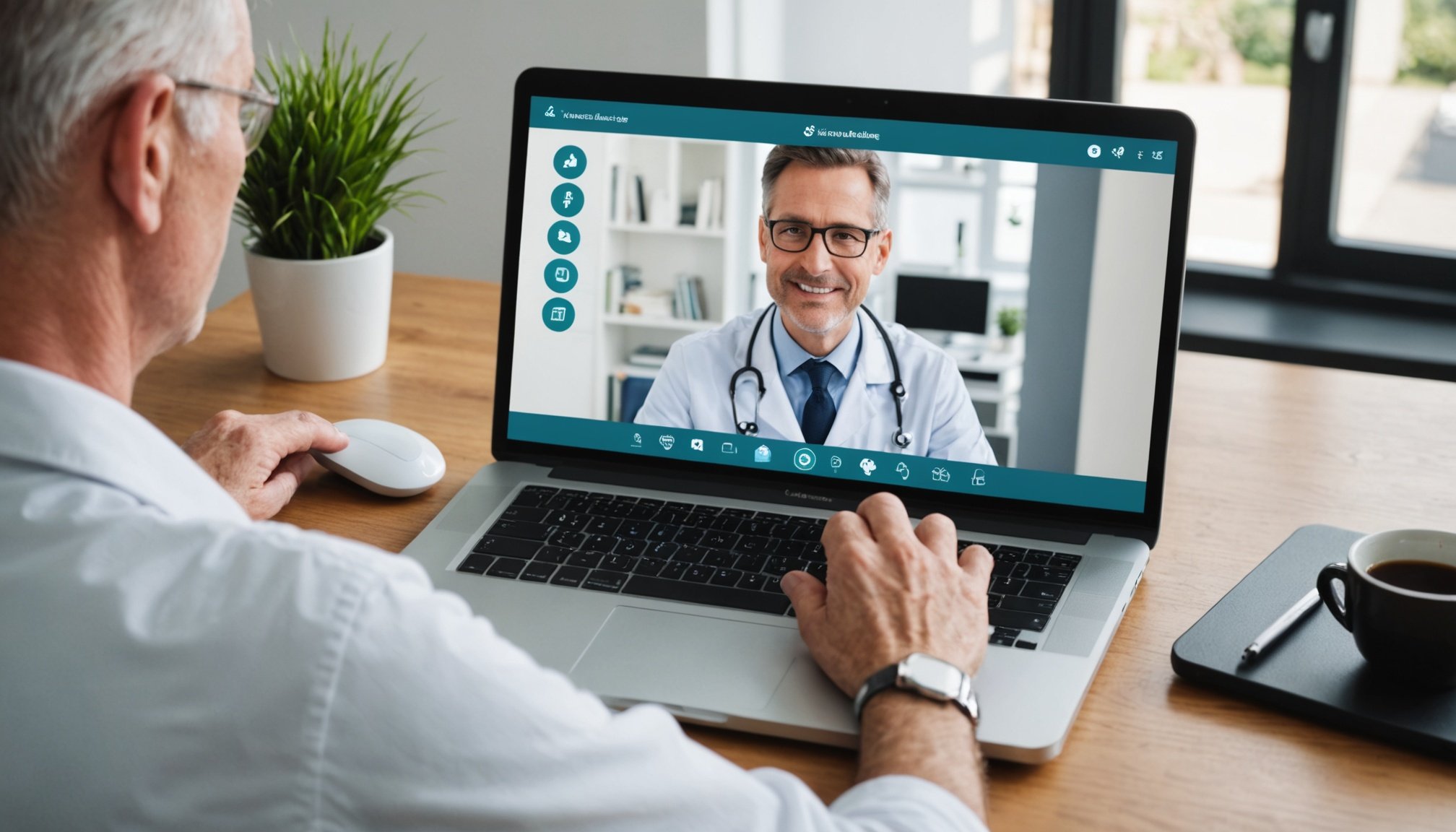Your Essential Guide to Launching Telemedicine in UK Clinics: Key Steps for Achieving Success
Understanding the Basics of Telemedicine
Before diving into the nitty-gritty of launching a telemedicine service in your UK clinic, it’s crucial to understand what telemedicine is and its potential benefits. Telemedicine, often interchangeably used with telehealth, involves the use of digital technologies to deliver medical care remotely. This can include video consultations, real-time messaging, and even remote monitoring of patients.
Telemedicine has gained significant traction, especially post-COVID-19, as it offers a convenient, accessible, and often more efficient way to deliver healthcare services. For instance, a pilot study at Guy’s and St Thomas’ NHS Foundation Trust implemented advice and guidance (AAG) clinics using telemedicine, which allowed for remote specialist advice in areas like restorative dentistry and periodontology[1].
Topic to read : Transforming London Consulting Firms: Innovative Strategies for Smooth Cloud CRM Integration
Assessing Your Clinic’s Readiness
Evaluating Your Patient Needs
To ensure the success of your telemedicine service, you need to understand the needs of your patients. This involves conducting surveys or focus groups to determine which services would be most beneficial to them. For example, if your clinic specializes in mental health, you might find that patients are keen on virtual therapy sessions and mood tracking tools[4].
Assessing Your Infrastructure
Your clinic’s infrastructure is critical for the smooth operation of telemedicine services. Here are a few key aspects to consider:
This might interest you : Essential Factors for Crafting a Successful BYOD Policy for Bristol’s Marketing Agencies
- Technology and Software: You will need robust and secure software that supports video consultations, data storage, and possibly AI-powered features like symptom checkers and predictive analytics[2][4].
- Internet Connectivity: Reliable high-speed internet is essential for real-time video consultations. The advent of 5G is expected to further enhance telemedicine by allowing faster processing of large data sets[4].
- Hardware: Ensure you have the necessary hardware such as high-quality cameras, microphones, and compatible devices.
Ensuring Compliance with Regulations
Telemedicine involves handling sensitive patient data, so compliance with healthcare regulations like HIPAA and NHS guidelines is paramount. Here are some steps to ensure compliance:
- Data Security: Implement robust data security measures, including the use of blockchain technology to secure patient data in a decentralized and immutable format[4].
- Privacy Policies: Develop clear privacy policies and ensure that all staff are trained on data protection and confidentiality.
- Technical Compliance: Ensure your telemedicine app complies with technical standards like HL7 and other relevant healthcare regulations[2].
Developing Your Telemedicine App
Key Features to Include
When developing your telemedicine app, several features are essential to ensure a seamless and effective user experience:
- Video Consultations: High-definition video conferencing integration is crucial for real-time consultations[2][4].
- Appointment Scheduling: A user-friendly appointment scheduling system, possibly integrated with AI for predictive analytics and chatbot support[2][4].
- E-Prescription Management: The ability to issue and manage electronic prescriptions securely[2].
- Patient History Records: Access to comprehensive patient history records to aid in diagnosis and treatment planning[2].
- Real-Time Notifications: Custom notification systems to keep patients and healthcare providers informed about appointments and updates[2].
AI Integration
AI can significantly enhance the functionality of your telemedicine app. Here are some ways AI can be integrated:
- AI-Powered Symptom Checkers: AI can help patients identify potential health issues based on their symptoms, providing initial diagnoses and recommendations[2][4].
- Predictive Analytics: AI can analyze patient data to predict health outcomes and suggest preventive measures[4].
- Chatbot Integration: AI-powered chatbots can assist with appointment scheduling, answer common questions, and provide basic health advice[2][4].
Implementing Telemedicine Services
Training Your Staff
The success of your telemedicine service heavily depends on the training and comfort level of your healthcare professionals. Here are some steps to ensure your staff is well-prepared:
- Technical Training: Provide comprehensive training on the use of the telemedicine software and hardware.
- Clinical Training: Ensure that healthcare providers are trained on how to conduct effective video consultations and use digital tools for diagnosis and treatment planning.
- Ongoing Support: Offer ongoing support and feedback mechanisms to help staff adapt to the new system.
Patient Onboarding
Onboarding patients to your telemedicine service is crucial for its adoption and success. Here are some steps to consider:
- Clear Instructions: Provide clear instructions on how to use the telemedicine app, including step-by-step guides and video tutorials.
- Technical Support: Offer technical support to help patients troubleshoot any issues they may encounter.
- Feedback Mechanisms: Establish feedback mechanisms to understand patient experiences and improve the service.
Case Studies and Best Practices
Successful Implementations
Looking at successful implementations can provide valuable insights. For example, the pilot study at Guy’s and St Thomas’ NHS Foundation Trust showed that telemedicine can be effectively used for remote specialist advice in dentistry, including restorative dentistry and periodontology. This service also facilitated remote multidisciplinary meetings for patients with hypodontia[1].
Lessons Learned
Here are some lessons learned from successful telemedicine implementations:
- Patient Engagement: Engaging patients from the outset is crucial. This includes educating them about the benefits and how to use the telemedicine service effectively.
- Continuous Improvement: Regularly gather feedback from both patients and healthcare providers to continuously improve the service.
- Interdisciplinary Collaboration: Encourage collaboration between different healthcare professionals to ensure comprehensive care.
Overcoming Challenges
Common Challenges
While telemedicine offers numerous benefits, there are also challenges to overcome:
- Technical Issues: Technical issues such as poor internet connectivity or hardware malfunctions can disrupt services. Having a robust technical support system in place can help mitigate these issues.
- Patient Resistance: Some patients may be resistant to the idea of telemedicine. Educating them about the benefits and ensuring a smooth onboarding process can help alleviate these concerns.
- Data Security: Ensuring the security of patient data is a significant challenge. Implementing robust security measures, including blockchain technology, can help address this concern[4].
Future Trends in Telemedicine
Emerging Technologies
Telemedicine is continuously evolving with the integration of emerging technologies. Here are some trends to watch out for in 2025:
- Augmented Reality (AR): AR is expected to play a significant role in enhancing diagnostic capabilities, particularly in fields like dermatology, ophthalmology, and physical therapy[4].
- 5G Connectivity: The high-speed connectivity offered by 5G will make telemedicine apps more effective, accessible, and dependable[4].
- Blockchain for Data Security: Blockchain technology will become more prevalent in securing patient data and ensuring compliance with healthcare regulations[4].
Practical Insights and Actionable Advice
Building a Successful Telemedicine Service
Here are some practical insights and actionable advice for building a successful telemedicine service:
- Start Small: Begin with a pilot program to test the waters and gather feedback before scaling up.
- Patient-Centric Approach: Always keep the patient at the center of your service. Ensure that the telemedicine app is user-friendly and addresses their specific needs.
- Continuous Training: Provide ongoing training for your staff to ensure they are comfortable and proficient with the telemedicine software and hardware.
- Feedback Loop: Establish a feedback loop to continuously improve the service based on patient and healthcare provider feedback.
Example of a Successful Telemedicine App Development Roadmap
Here is an example of a roadmap for developing a telemedicine app, as outlined by The NineHertz:
| Phase | Activities |
|---|---|
| Discovery and Planning | One-to-one discussion with the client, assess target audiences, key features, and project goals. Craft a comprehensive project roadmap with important milestones and timelines. Analyze technical compliance with healthcare regulations like HIPAA[2]. |
| Design | Craft a user-friendly interface, deploy a prototype for client feedback, ensure multi-device compatibility, and finalize the design with seamless navigation and data protection[2]. |
| Development | Deploy the best technologies to build a scalable app architecture, integrate advanced technologies like AI, EHR, and telemedicine features. Ensure industry standards and adherence to healthcare regulations[2]. |
| Testing | Conduct rigorous functional, security, and performance testing. Validate legal compliance with relevant healthcare standards like HIPAA and HL7. Perform usability testing to ensure a seamless user experience[2]. |
| Deployment & Release | Prepare the app for smooth deployment on targeted platforms, deploy final checks for readiness, release the software, and provide training to stakeholders. Entertain client and user feedback after deployment[2]. |
Launching a telemedicine service in your UK clinic is a significant step towards enhancing patient care and improving healthcare accessibility. By understanding the basics of telemedicine, assessing your clinic’s readiness, developing a robust telemedicine app, and implementing the service effectively, you can ensure the success of your telemedicine initiative.
As Dr. Salim Chauhan from EMed HealthTech notes, “Telemedicine in 2025 is set to be more advanced, secure, and accessible than ever before, thanks to ongoing innovations in app development. By adopting these trends, healthcare providers can offer more reliable, efficient, and comprehensive care for a broad spectrum of patients.”[4]
By following the steps outlined in this guide and staying abreast of the latest trends and technologies, you can make your telemedicine service a cornerstone of your clinic’s patient care strategy.











